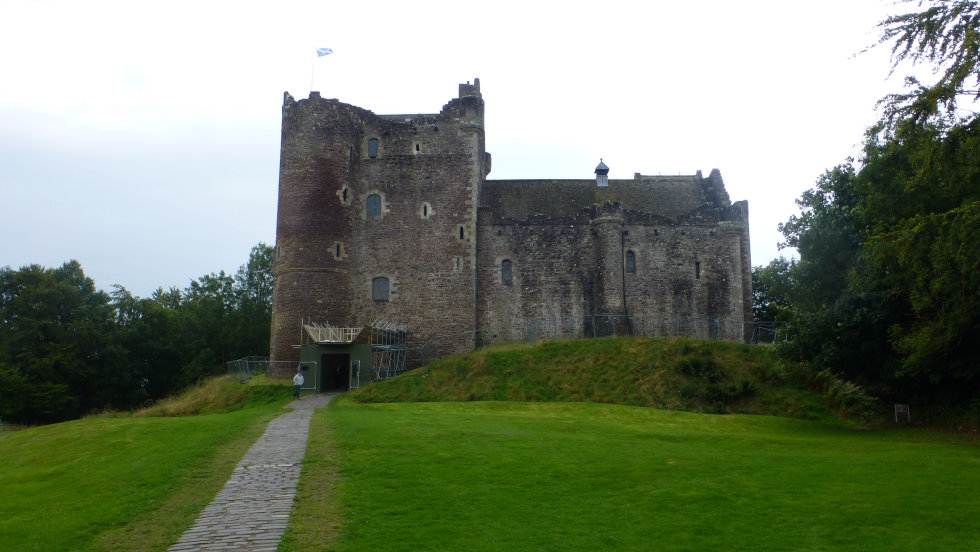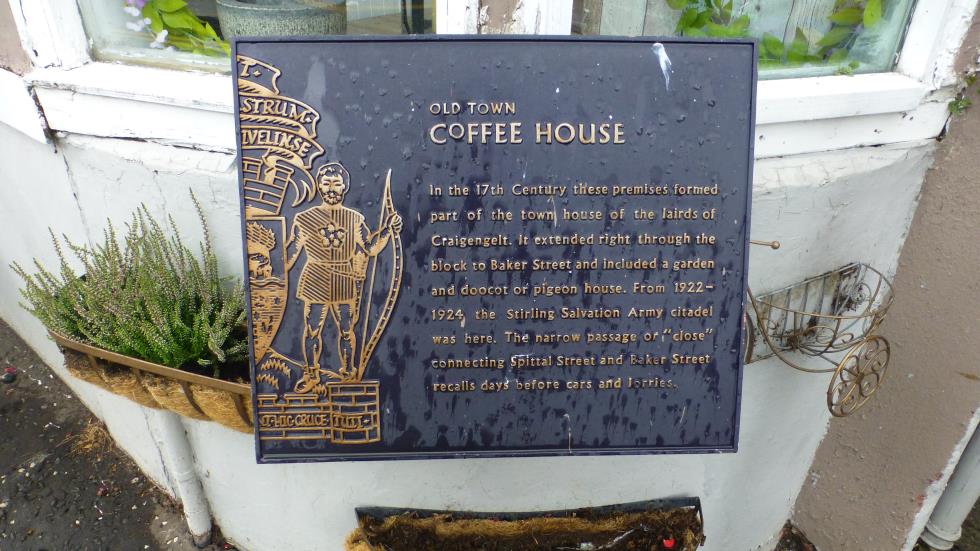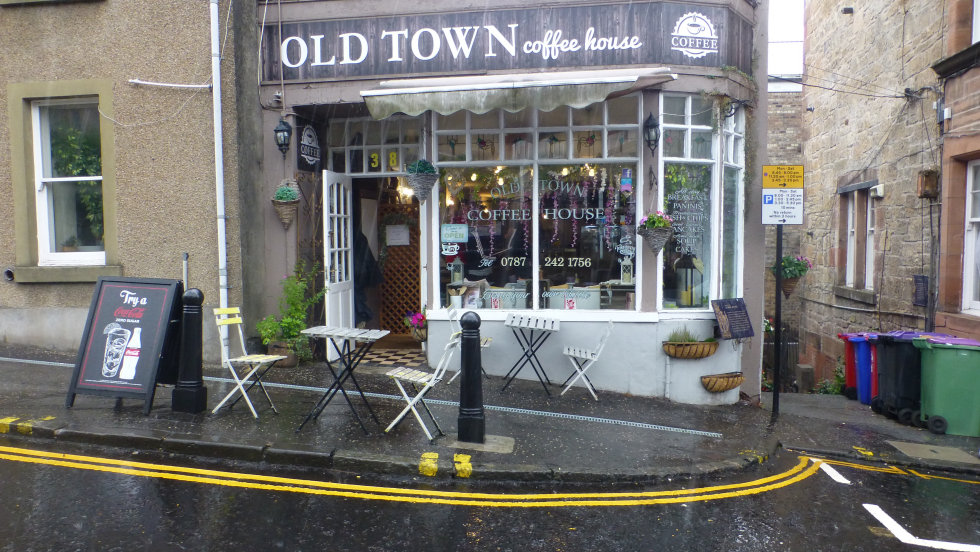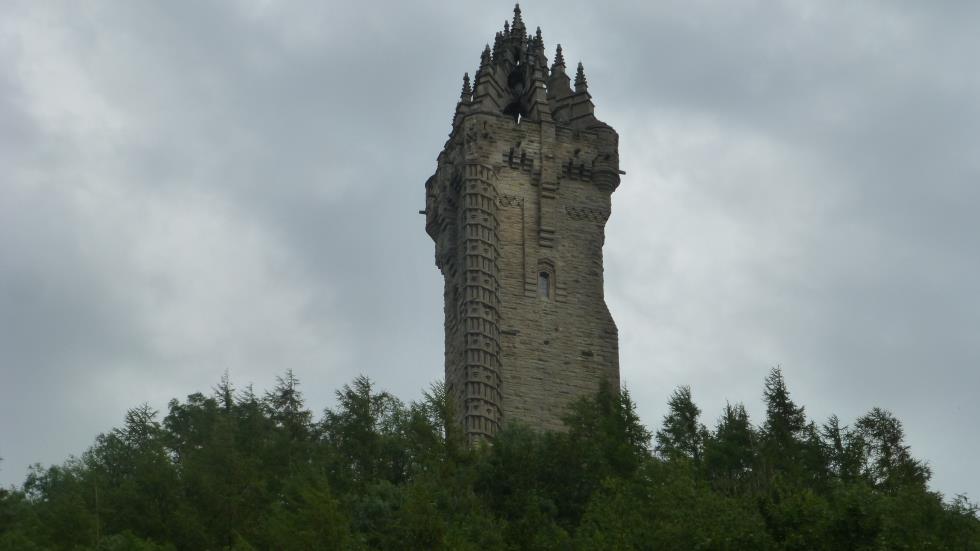Day 10 - Doune, Stirling & the Falkirk Wheel

Today is our last full day here in Scotland. We will be leaving our Holyrood Palace location and will spend our
final night near the airport. Meanwhile, we have this final day to spend exploring the near environs of
Edinburgh.With but a little discussion, we decided to drive the short distance to Stirling and Doune
Castles. Our Lady of the GPS chose to take us to Doune first.
I had visited Doune several times with Alex on his tours. On more than one occasion he was moved to sing a verse in his low gravelly voice from The Bonnie Earl O' Moray.
We stayed to the outside of the castle since, as with the others, most of the interior was not accessible due to modifications.

 sound Scottish. While Cissy chose some delicious looking chocolate crepes with ice cream and John had
sound Scottish. While Cissy chose some delicious looking chocolate crepes with ice cream and John had the full Scottish breakfast (including fried eggs, bacon, baked beans, haggis, broiled tomato,
sausage, mushrooms and toast), I had a simple bowl of porridge with red, sweet (though unsweetened)
strawberries with warmed cream and what is probably the best cup of coffee in Scotland. I would highly
recommend this establishment the next time you are anywhere near Stirling, Scotland.
the full Scottish breakfast (including fried eggs, bacon, baked beans, haggis, broiled tomato,
sausage, mushrooms and toast), I had a simple bowl of porridge with red, sweet (though unsweetened)
strawberries with warmed cream and what is probably the best cup of coffee in Scotland. I would highly
recommend this establishment the next time you are anywhere near Stirling, Scotland.
Sitting high on a volcanic outcropping, Stirling, along with Edinburgh Castle are probably the two most important castles in Scottish history. While the site of Stirling has probably housed fortifications for thousands of years, the first report of a castle was of a siege by Kenneth MacAlpin, first King of Scots (and, I might add, my 35th great grandfather) in his war to also become the King of Picts. The first trusted record of a Stirling Castle dates from c.1110 when King Alexander I dedicated a chapel there which became a royal center. King David I, Alexander's successor, declared it a royal burgh. It was captured by the English in 1174 but was formally returned by King Richard I, The Lion Heart, in 1189. The Castle swapped ownership many times over the centuries.
Stirling being another castle of many levels and I, continuing in my illness, waited in the parking lot taking selfies and finally in the car as the weather grew increasingly more Scottish. Cissy and John returned after about an hour, being very impressed with the Castle. However, the weather had turned quite windy, the rain had increased and the temperature had dropped. They were very put out with it. I, however, pointed out that THIS was the true Scottish weather we should have endured our entire journey, not the lovely, sunny, warm weather we actually encountered.




The monument itself towers 220' above the shoulder of Abbey Craig. From here, Stirling Castle is visible 2.5 miles southwest across the Firth River Valley. On this day, though the air was hazy, I was able to get a photo to match with the photo of the monument that I had taken from the Castle those many years before.


By 1996, sufficient funds had been raised, with some finagling, to reopen the canals. The current design was arrived at and, in May of 2002, QEII opened the Wheel as part of her Golden Jubilee celebrations.
While the Wheel looks complex as does the operation, nothing could be further from the truth. The Wheel is basically a Ferris wheel, 79 feet in diameter, with two gondolas, one carrying a barge going up and the other going down. In accordance with the principles determined by the ancient Greek engineer, Archimedes, when the barges enter each of the gondolas, they displace the amount of water equal to their weight, leaving each loaded gondola with the same weight (weight of the barge plus weight of the total water in the gondola less the volume of water displaced by the barge and equal to its weight which is ejected from the gondola before the gate is close). So a barge entering one gondola loaded with partying football players results in the same total gondola weight as the other gondola carrying a Daniel Boone reenactor in a birch bark canoe! To spin the two gondolas (gondolae?) a 30hp electric motor expending the energy equivalent to boiling eight kettles of water (English kettles I assume) is all that is required.
The original model for the Wheel was developed by the designer, Tony Kettle, using the pieces from his 8 year old daughter's Lego set. (Rumor is that his daughter built it and he stole the design but I do not put much credence behind it.)
Upon the transport of the first two barges at the opening ceremony, QEII was heard to exclaim "And Bob's your Uncle!".
Having reoriented our technical viewpoint in readiness for our return flight, we moved on to our final AirBnb site for our final night. For some reason, we all agreed to dinner at local "carvery". For those not familiar, a carvery is just that - large chunks of roast beef, turkey and gammon (ham) carved as you wait, laid on a plate and you are then free to add Yorkshire pudding and various vegetables. Similar to the British Sunday lunch, it came nowhere near the quality of The Townhouse in Melrose. We agreed later that we should have ended out Scottish adventure as we began 10 days earlier - with a fine serving of fish and chips (and beer).


And with that, we said Adieu to Scotland. For the last time? Certainly for some...but perhaps not for all.
Doune Castle
Doune Castle was probably originally constructed in the 13th century. It was rebuilt to its present form, a Tower Castle with a courtyard, in the late 14th century by Robert Stewart, son of King Robert II and Regent of Scotland. In the later 16th century it came under the Earls of Moray. Falling in ruins in the early 1800s, restoration works were begun in the 1880s and today it is maintained by Historic Environment Scotland.I had visited Doune several times with Alex on his tours. On more than one occasion he was moved to sing a verse in his low gravelly voice from The Bonnie Earl O' Moray.
Doune Castle from its earlier appearance in Monty Python and the Holy Grail. For those more sophisticated, it served as Castle Leoch, You might recognize the fictional seat of Clan MacKenzie, in Outlander and as Winterfell in Game of Thrones. It has served in many other works centered around ancient Scotland.Ye heilands and ye lowlands,
O whaur hae ye been?
They hae slain the Earl o' Murray,
And laid him on the green;
He was a braw gallant,
And he rade at the ring;
And the bonnie Earl o' Murray
O He micht hae been the king.
O lang will his lady
Look o'er the castle Doune,
Ere she see the Earl o' Murray
Come soundin' thro' the toon.
We stayed to the outside of the castle since, as with the others, most of the interior was not accessible due to modifications.
Stirling Castle
From Doune, we headed back southwest to Stirling Castle. As we wound through the streets of Stirling, often making the wrong turn, we came upon the Old Town Coffee House. Having had only a light breakfast, we quickly decided to stop for more. The proprietors appeared to be French as they certainly did notSitting high on a volcanic outcropping, Stirling, along with Edinburgh Castle are probably the two most important castles in Scottish history. While the site of Stirling has probably housed fortifications for thousands of years, the first report of a castle was of a siege by Kenneth MacAlpin, first King of Scots (and, I might add, my 35th great grandfather) in his war to also become the King of Picts. The first trusted record of a Stirling Castle dates from c.1110 when King Alexander I dedicated a chapel there which became a royal center. King David I, Alexander's successor, declared it a royal burgh. It was captured by the English in 1174 but was formally returned by King Richard I, The Lion Heart, in 1189. The Castle swapped ownership many times over the centuries.
Stirling being another castle of many levels and I, continuing in my illness, waited in the parking lot taking selfies and finally in the car as the weather grew increasingly more Scottish. Cissy and John returned after about an hour, being very impressed with the Castle. However, the weather had turned quite windy, the rain had increased and the temperature had dropped. They were very put out with it. I, however, pointed out that THIS was the true Scottish weather we should have endured our entire journey, not the lovely, sunny, warm weather we actually encountered.
The National Wallace Monument
Leaving Stirling, Cissy asked if we could stop by the nearby National Wallace Monument. On my first trip to Scotland with Alex back in 2003, we had stopped briefly for a photo op at the then statue of William Wallace as portrayed by Mel Gibson. I learned that the statue had been removed because, according to our shuttle bus driver, people didn't believe it accurately portrayed Wallace. (In truth, Wallace was 6' 7" while Gibson was 5' 9". Alex always said that Liam Neeson, who was 6' 4", should have portrayed Wallace while Gibson should have played the part of Rob Roy MacGregor, a man of average height, say 5' 8".) I believe that the removal of this statue is probably more related to his anti-Semitic comments and the PC crowd. This totally ignores the tourist dollars that the movie, Braveheart, brought to Scotland.The monument itself towers 220' above the shoulder of Abbey Craig. From here, Stirling Castle is visible 2.5 miles southwest across the Firth River Valley. On this day, though the air was hazy, I was able to get a photo to match with the photo of the monument that I had taken from the Castle those many years before.
The Falkirk Wheel
Our last stop on our visit to Scotland turned out to be not an ancient site of power and mystery, but the modern site of technology. The Falkirk Wheel is a rotating boat lift that connects the Forth and Clyde Canal with the Union Canal. Prior to 1933, the canals were connected by a series of 11 locks that lifted the 115 feet between the two canals and took an entire day to traverse. The canals fell into disuse and they closed.By 1996, sufficient funds had been raised, with some finagling, to reopen the canals. The current design was arrived at and, in May of 2002, QEII opened the Wheel as part of her Golden Jubilee celebrations.
While the Wheel looks complex as does the operation, nothing could be further from the truth. The Wheel is basically a Ferris wheel, 79 feet in diameter, with two gondolas, one carrying a barge going up and the other going down. In accordance with the principles determined by the ancient Greek engineer, Archimedes, when the barges enter each of the gondolas, they displace the amount of water equal to their weight, leaving each loaded gondola with the same weight (weight of the barge plus weight of the total water in the gondola less the volume of water displaced by the barge and equal to its weight which is ejected from the gondola before the gate is close). So a barge entering one gondola loaded with partying football players results in the same total gondola weight as the other gondola carrying a Daniel Boone reenactor in a birch bark canoe! To spin the two gondolas (gondolae?) a 30hp electric motor expending the energy equivalent to boiling eight kettles of water (English kettles I assume) is all that is required.
The original model for the Wheel was developed by the designer, Tony Kettle, using the pieces from his 8 year old daughter's Lego set. (Rumor is that his daughter built it and he stole the design but I do not put much credence behind it.)
Upon the transport of the first two barges at the opening ceremony, QEII was heard to exclaim "And Bob's your Uncle!".
Having reoriented our technical viewpoint in readiness for our return flight, we moved on to our final AirBnb site for our final night. For some reason, we all agreed to dinner at local "carvery". For those not familiar, a carvery is just that - large chunks of roast beef, turkey and gammon (ham) carved as you wait, laid on a plate and you are then free to add Yorkshire pudding and various vegetables. Similar to the British Sunday lunch, it came nowhere near the quality of The Townhouse in Melrose. We agreed later that we should have ended out Scottish adventure as we began 10 days earlier - with a fine serving of fish and chips (and beer).
Day 11 - The Day of our Farewell
A nights rest and we were left with on final hurdle - returning the rental car. As I noted on Day 1, the distance from the car rental desk to the gate was 2,394.5± feet. While my mysterious illness was improving, I did not relish the walk in my continued weakened state. However, with several stops to re-energize, we finally found Cissy with all of the luggage where John had left her. One final comment on EDI airport. I do not like dissing other countries' facilities, but EDI could use a major overhaul including external shuttles and internal automated walkways. One thing that doesn't need updating - the duty-free shops you have to traverse to get to the gates. These would rival many 5th Ave shops. That part of the trip could be shortened or even eliminated.And with that, we said Adieu to Scotland. For the last time? Certainly for some...but perhaps not for all.
 To Day 1 - We Encounter the Haggis
To Day 1 - We Encounter the Haggis